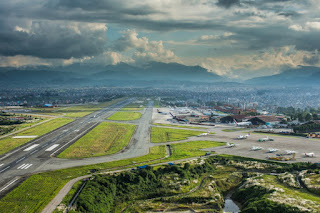Six residential houses adjacent to
the southern boundary of Tribhuvan International Airport have been deemed to be
too close to the airport for safety reasons while four others are found to be
in critical zone, according to a report prepared by Kathmandu Metropolitan
City.A technical team under KMC engineer Bir Bahadur Khadka came to the finding
after conducting an obstacle survey at Palpakpot, Koteshwor in KMC Ward no 35,
which lies on the southern end of TIA.Among the buildings in the area, west of
Pespicola-Jadibuti road, six were found to be on obstacle limitation surface,
an area beyond the boundary of the aerodrome that must be protected from
obstacles so that aircrafts can conduct safe takeoff and landing.
Likewise, four buildings were found
to be on the critical zone, meaning that no further physical structure can be
added to them. Rest of the buildings have been cleared by the Khadka-led committee.
Earlier, people living in the area had filed a complaint at parliamentary
development committee after Civil Aviation Authority of Nepal had decided to
reacquire 149 ropanis of land eight years after the owners were permitted to
build houses on their plots. Caan’s move was aimed at constructing drainage and
extending airport perimeter for preventing construction of houses on the
southern side of the airport for air safety.KMC has not yet officially decided
the fate of the buildings that have found to be threatening air safety but
sources say they will most likely be demolished. source by Kathmandu post
Himalayan Smile Treks and
Adventures Pvt. Ltd.
Email: sales@himalayastrek.com|info@himalayastrek.com
Seven Corner Road | Thamel | G.P.O.Box No.13216 |
Kathmandu | Nepal
Tel: 977-1-4700386 | 977-1-4700446 | Fax: 977-1-4701336
Skype: himalayan.smile.treks
Web: www.himalayastrek.com | www.himalayansmiletrek.com
Skype: himalayan.smile.treks
Web: www.himalayastrek.com | www.himalayansmiletrek.com






